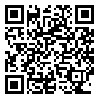Wed, Dec 31, 2025
[Archive]
Volume 3, Issue 2 (9-2013)
J Adv Biomed Sci. 2013, 3(2): 93-103 |
Back to browse issues page
Download citation:
BibTeX | RIS | EndNote | Medlars | ProCite | Reference Manager | RefWorks
Send citation to:



BibTeX | RIS | EndNote | Medlars | ProCite | Reference Manager | RefWorks
Send citation to:
Fanaei H, Azizi Y, Khayat S. A Review: Role of oxidative stress in male infertility. J Adv Biomed Sci. 2013; 3 (2) :93-103
URL: http://jabs.fums.ac.ir/article-1-337-en.html
URL: http://jabs.fums.ac.ir/article-1-337-en.html
1- Department of Physiology, Medical School, Zahedan University of Medical Sciences, Zahedan, Iran. , : fanaei@razi.tums.ac.ir
2- Department of Physiology, Medical School, Tehran University of Medical Sciences, Tehran, Iran.
3- Department of Midwifery, Nursing and Midwifery Faculty, Tehran University of Medical Sciences, Tehran. Iran
2- Department of Physiology, Medical School, Tehran University of Medical Sciences, Tehran, Iran.
3- Department of Midwifery, Nursing and Midwifery Faculty, Tehran University of Medical Sciences, Tehran. Iran
Abstract: (32565 Views)
Recent studies have shown that reactive oxygen species (ROS) have a very important role in the intracellular signaling process in physiological conditions. On the other hand, during the recent decade it has been indicated that ROS play a role in various types of male infertility and it is due to the overproduction of ROS or decrease in the antioxidant defense system in the reproductive system and sperm. In pathological conditions, ROS via interferences in the spermatogenesis process, sperm function, and sperm structure (motility, viability, acrosome reaction, sperm-oocyte fusion, and damage to DNA and cell membrane) as well as reduction in fertilization and implantation can lead to infertility. Knowledge of how ROS affect the physiological process of the reproductive system is crucial in the treatment of infertility. Thus, in this review article we will discuss experimental and clinical findings related to the effects of ROS on male fertility.
Type of Study: Review |
Subject:
Physiology
Received: 2013/09/14 | Revised: 2013/10/6 | Accepted: 2013/10/6 | Published: 2013/10/6
Received: 2013/09/14 | Revised: 2013/10/6 | Accepted: 2013/10/6 | Published: 2013/10/6
Send email to the article author
| Rights and permissions | |
 |
This work is licensed under a Creative Commons Attribution-NonCommercial 4.0 International License. |

This work is licensed under a Creative Commons — Attribution-NonCommercial 4.0 International (CC BY-NC 4.0)



